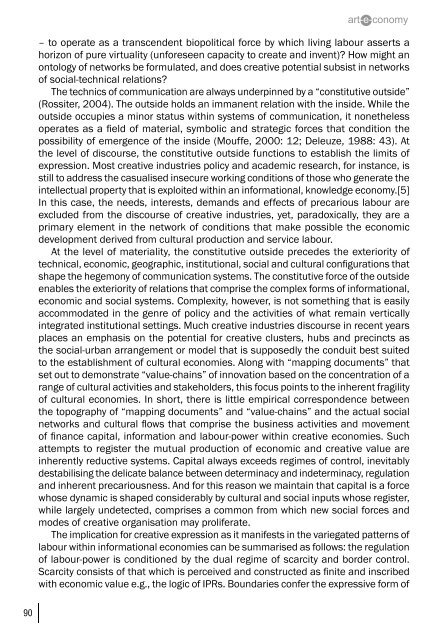art-e-conomy _ reader - marko stamenkovic
art-e-conomy _ reader - marko stamenkovic
art-e-conomy _ reader - marko stamenkovic
You also want an ePaper? Increase the reach of your titles
YUMPU automatically turns print PDFs into web optimized ePapers that Google loves.
90<br />
– to operate as a transcendent biopolitical force by which living labour asserts a<br />
horizon of pure virtuality (unforeseen capacity to create and invent)? How might an<br />
ontology of networks be formulated, and does creative potential subsist in networks<br />
of social-technical relations?<br />
The technics of communication are always underpinned by a “constitutive outside”<br />
(Rossiter, 2004). The outside holds an immanent relation with the inside. While the<br />
outside occupies a minor status within systems of communication, it nonetheless<br />
operates as a field of material, symbolic and strategic forces that condition the<br />
possibility of emergence of the inside (Mouffe, 2000: 12; Deleuze, 1988: 43). At<br />
the level of discourse, the constitutive outside functions to establish the limits of<br />
expression. Most creative industries policy and academic research, for instance, is<br />
still to address the casualised insecure working conditions of those who generate the<br />
intellectual property that is exploited within an informational, knowledge e<strong>conomy</strong>.[5]<br />
In this case, the needs, interests, demands and effects of precarious labour are<br />
excluded from the discourse of creative industries, yet, paradoxically, they are a<br />
primary element in the network of conditions that make possible the economic<br />
development derived from cultural production and service labour.<br />
At the level of materiality, the constitutive outside precedes the exteriority of<br />
technical, economic, geographic, institutional, social and cultural configurations that<br />
shape the hegemony of communication systems. The constitutive force of the outside<br />
enables the exteriority of relations that comprise the complex forms of informational,<br />
economic and social systems. Complexity, however, is not something that is easily<br />
accommodated in the genre of policy and the activities of what remain vertically<br />
integrated institutional settings. Much creative industries discourse in recent years<br />
places an emphasis on the potential for creative clusters, hubs and precincts as<br />
the social-urban arrangement or model that is supposedly the conduit best suited<br />
to the establishment of cultural economies. Along with “mapping documents” that<br />
set out to demonstrate “value-chains” of innovation based on the concentration of a<br />
range of cultural activities and stakeholders, this focus points to the inherent fragility<br />
of cultural economies. In short, there is little empirical correspondence between<br />
the topography of “mapping documents” and “value-chains” and the actual social<br />
networks and cultural flows that comprise the business activities and movement<br />
of finance capital, information and labour-power within creative economies. Such<br />
attempts to register the mutual production of economic and creative value are<br />
inherently reductive systems. Capital always exceeds regimes of control, inevitably<br />
destabilising the delicate balance between determinacy and indeterminacy, regulation<br />
and inherent precariousness. And for this reason we maintain that capital is a force<br />
whose dynamic is shaped considerably by cultural and social inputs whose register,<br />
while largely undetected, comprises a common from which new social forces and<br />
modes of creative organisation may proliferate.<br />
The implication for creative expression as it manifests in the variegated patterns of<br />
labour within informational economies can be summarised as follows: the regulation<br />
of labour-power is conditioned by the dual regime of scarcity and border control.<br />
Scarcity consists of that which is perceived and constructed as finite and inscribed<br />
with economic value e.g., the logic of IPRs. Boundaries confer the expressive form of


